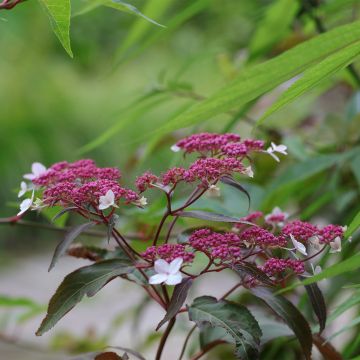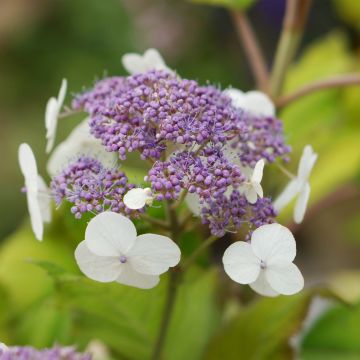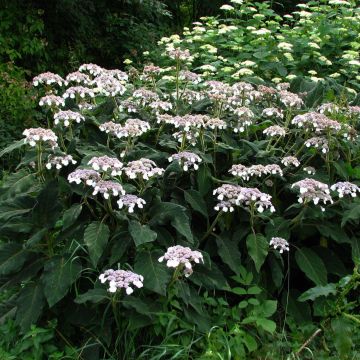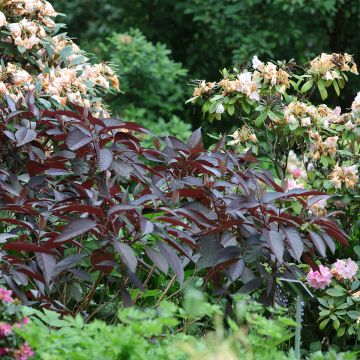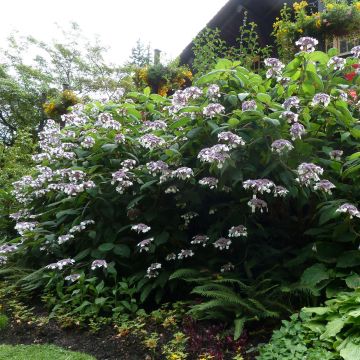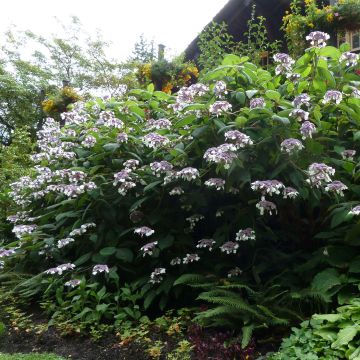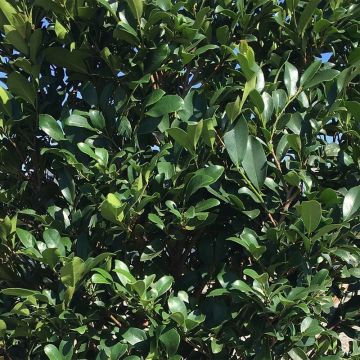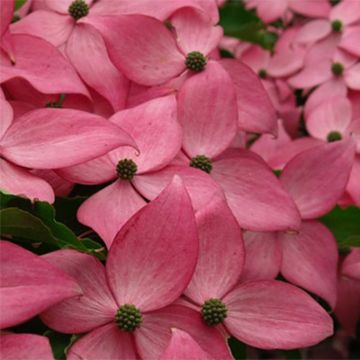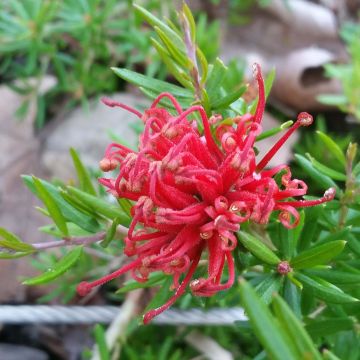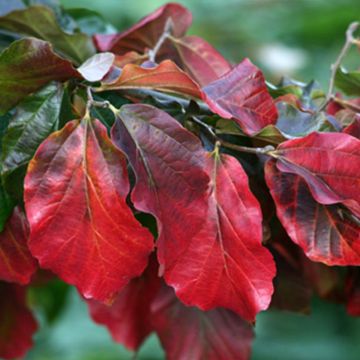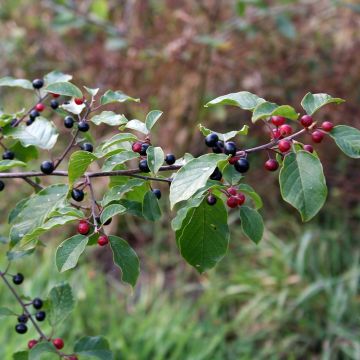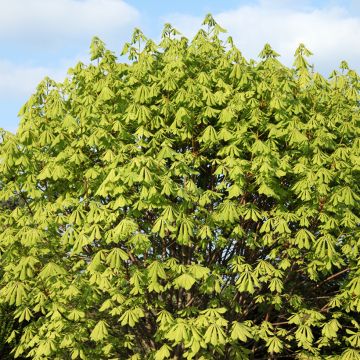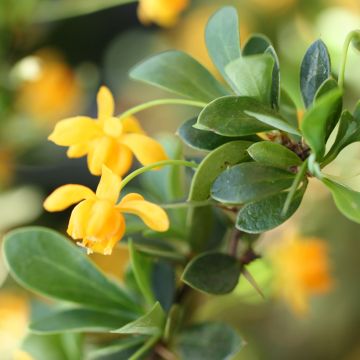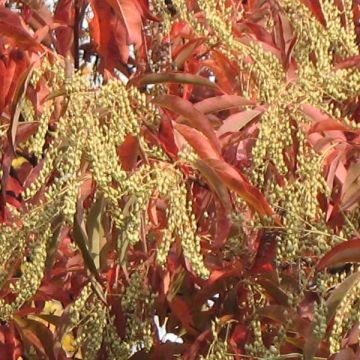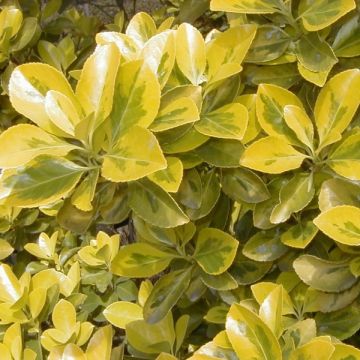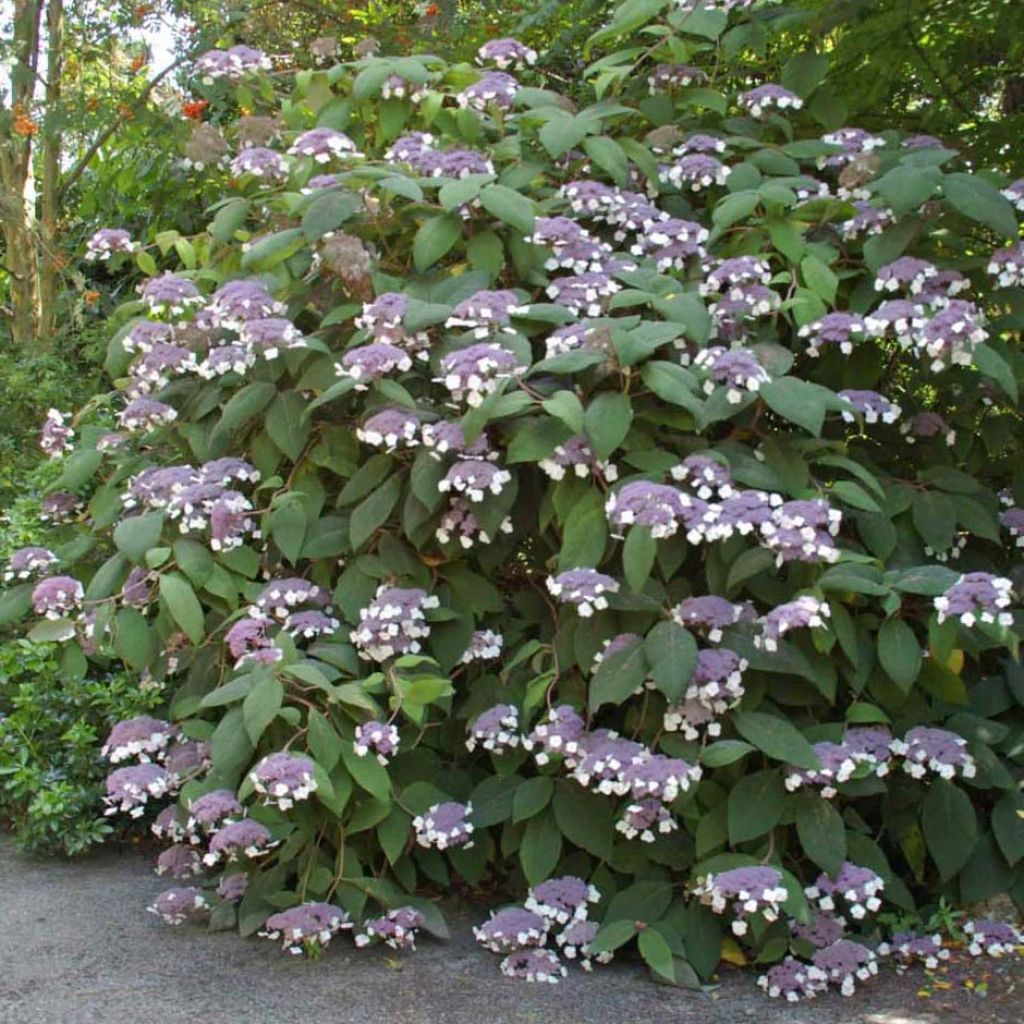

Hydrangea aspera Bellevue
Hydrangea aspera Bellevue
Hydrangea aspera Bellevue
Rough-leaved Hydrangea, Aspera Hydrangea
Arrived in poor condition. Dry, yellow or pendulous leaves. I hope it will recover...
Jean-Claude, 10/09/2023
This item cannot be shipped to the selected country
Delivery charge from €5.90
More information
Schedule delivery date,
and select date in basket
This plant carries a 24 months recovery warranty
More information
We guarantee the quality of our plants for a full growing cycle, and will replace at our expense any plant that fails to recover under normal climatic and planting conditions.
From €5.90 for pickup delivery and €6.90 for home delivery
Express home delivery from €8.90.
Does this plant fit my garden?
Set up your Plantfit profile →
Description
Hydrangea aspera 'Bellevue' is a rare hybrid hydrangea in cultivation, spectacular for its significant development and gigantic leaves, but not demanding in terms of soil, as long as it remains moist. On its large velvety leaves, large flat inflorescences with a slightly rounded shape appear in the middle of summer, invariably coloured in a soft blue-lilac and adorned with a few white florets, as their colour is not greatly influenced by the soil's pH. A variety suitable for large spaces, an absolute must-see!
Originally from a large part of southern and eastern Asia, where it shows great variability, Hydrangea aspera is a completely hardy large bush belonging to the Hydrangeaceae family, and a close relative of hydrangeas with large leaves and ball-shaped inflorescences.
The 'Bellevue' variety is a French hybrid cultivar obtained by Lemonnier nurseries, resulting from the crossbreeding of Hydrangea aspera macrophylla and H. aspera sargentiana, a triploid form "struck" by gigantism. 'Bellevue' forms a very beautiful bush with an upright and bushy habit, reaching 3 m (9.8 ft) in all directions. In this hydrangea, the inflorescence, or corymb, is particularly dense and 30 cm (11.8 in) wide. It is made up of small flowers arranged in an umbrella shape. The sterile flowers, larger and fewer in number, form a very sparse crown around the small fertile flowers, which resemble small clustered buds in blue-mauve pink, opening into tiny lilac flowers from the outside to the inside of the corymb. This particular arrangement is called a granny's bonnet. Its deciduous foliage resembles that of Hydrangea aspera sargentiana, but darker. Its leaves measure up to 50 cm (19.7 in) long. They are lanceolate, denticulate, pubescent, more so on the underside. They are marked with fairly deep veins.
This bush likes cool, shady or semi-shady environments, but it is one of the few, along with Hydrangea quercifolia and its varieties, to be indifferent to the presence of limestone in the soil and to appreciate sunny, non-burning exposures. Naturally, it will also thrive in an ericaceous soil bed alongside other hydrangeas, Kalmia, or Azalea for example. Hydrangea aspera 'Bellevue' allows you to create a superb backdrop. Flower a free hedge with fragrant viburnums or large deciduous euonymus. Plant at the edge of a grove or a woodland. We recommend planting it near a path or a window, as it would be a shame not to enjoy its magnificence.
Report an error about the product description
Hydrangea aspera Bellevue in pictures
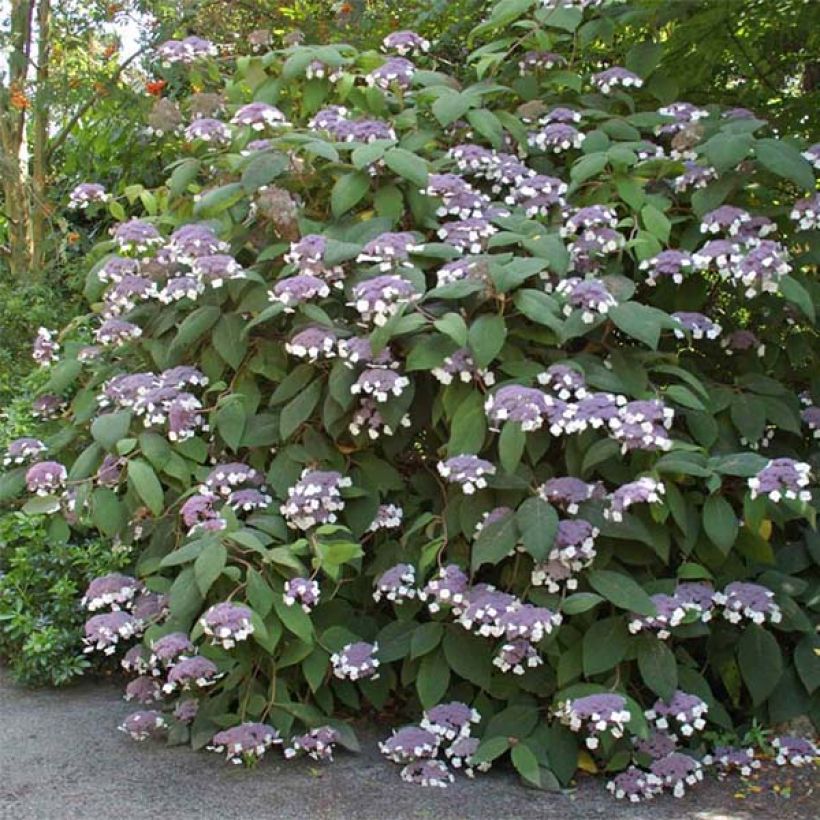

Plant habit
Flowering
Foliage
Botanical data
Hydrangea
aspera
Bellevue
Hydrangeaceae
Rough-leaved Hydrangea, Aspera Hydrangea
Cultivar or hybrid
Other Hydrangea aspera
Planting and care
Plant in a semi-shady or softly sunny position, in a hole filled with a mixture of garden soil, leaf compost, and ericaceous soil if your soil is very chalky. Normally, this variety grows well in ordinary, deep, well-drained soil that stays moist in summer. A supplement of well-rotted manure or compost is a plus. Adequate watering at the time of planting and during the first two years following planting is essential, and it is also recommended to water it occasionally during the summer in case of prolonged dryness. After September, stop all watering. In cold regions, protect the stumps with a layer of dead leaves, for example.
This large-growing variety of hydrangea is not suitable for container cultivation. It will be much happier in the ground.
Planting period
Intended location
Care
-
, onOrder confirmed
Reply from on Promesse de fleurs
Striking foliage shrubs
Haven't found what you were looking for?
Hardiness is the lowest winter temperature a plant can endure without suffering serious damage or even dying. However, hardiness is affected by location (a sheltered area, such as a patio), protection (winter cover) and soil type (hardiness is improved by well-drained soil).

Photo Sharing Terms & Conditions
In order to encourage gardeners to interact and share their experiences, Promesse de fleurs offers various media enabling content to be uploaded onto its Site - in particular via the ‘Photo sharing’ module.
The User agrees to refrain from:
- Posting any content that is illegal, prejudicial, insulting, racist, inciteful to hatred, revisionist, contrary to public decency, that infringes on privacy or on the privacy rights of third parties, in particular the publicity rights of persons and goods, intellectual property rights, or the right to privacy.
- Submitting content on behalf of a third party;
- Impersonate the identity of a third party and/or publish any personal information about a third party;
In general, the User undertakes to refrain from any unethical behaviour.
All Content (in particular text, comments, files, images, photos, videos, creative works, etc.), which may be subject to property or intellectual property rights, image or other private rights, shall remain the property of the User, subject to the limited rights granted by the terms of the licence granted by Promesse de fleurs as stated below. Users are at liberty to publish or not to publish such Content on the Site, notably via the ‘Photo Sharing’ facility, and accept that this Content shall be made public and freely accessible, notably on the Internet.
Users further acknowledge, undertake to have ,and guarantee that they hold all necessary rights and permissions to publish such material on the Site, in particular with regard to the legislation in force pertaining to any privacy, property, intellectual property, image, or contractual rights, or rights of any other nature. By publishing such Content on the Site, Users acknowledge accepting full liability as publishers of the Content within the meaning of the law, and grant Promesse de fleurs, free of charge, an inclusive, worldwide licence for the said Content for the entire duration of its publication, including all reproduction, representation, up/downloading, displaying, performing, transmission, and storage rights.
Users also grant permission for their name to be linked to the Content and accept that this link may not always be made available.
By engaging in posting material, Users consent to their Content becoming automatically accessible on the Internet, in particular on other sites and/or blogs and/or web pages of the Promesse de fleurs site, including in particular social pages and the Promesse de fleurs catalogue.
Users may secure the removal of entrusted content free of charge by issuing a simple request via our contact form.
The flowering period indicated on our website applies to countries and regions located in USDA zone 8 (France, the United Kingdom, Ireland, the Netherlands, etc.)
It will vary according to where you live:
- In zones 9 to 10 (Italy, Spain, Greece, etc.), flowering will occur about 2 to 4 weeks earlier.
- In zones 6 to 7 (Germany, Poland, Slovenia, and lower mountainous regions), flowering will be delayed by 2 to 3 weeks.
- In zone 5 (Central Europe, Scandinavia), blooming will be delayed by 3 to 5 weeks.
In temperate climates, pruning of spring-flowering shrubs (forsythia, spireas, etc.) should be done just after flowering.
Pruning of summer-flowering shrubs (Indian Lilac, Perovskia, etc.) can be done in winter or spring.
In cold regions as well as with frost-sensitive plants, avoid pruning too early when severe frosts may still occur.
The planting period indicated on our website applies to countries and regions located in USDA zone 8 (France, United Kingdom, Ireland, Netherlands).
It will vary according to where you live:
- In Mediterranean zones (Marseille, Madrid, Milan, etc.), autumn and winter are the best planting periods.
- In continental zones (Strasbourg, Munich, Vienna, etc.), delay planting by 2 to 3 weeks in spring and bring it forward by 2 to 4 weeks in autumn.
- In mountainous regions (the Alps, Pyrenees, Carpathians, etc.), it is best to plant in late spring (May-June) or late summer (August-September).
The harvesting period indicated on our website applies to countries and regions in USDA zone 8 (France, England, Ireland, the Netherlands).
In colder areas (Scandinavia, Poland, Austria...) fruit and vegetable harvests are likely to be delayed by 3-4 weeks.
In warmer areas (Italy, Spain, Greece, etc.), harvesting will probably take place earlier, depending on weather conditions.
The sowing periods indicated on our website apply to countries and regions within USDA Zone 8 (France, UK, Ireland, Netherlands).
In colder areas (Scandinavia, Poland, Austria...), delay any outdoor sowing by 3-4 weeks, or sow under glass.
In warmer climes (Italy, Spain, Greece, etc.), bring outdoor sowing forward by a few weeks.

































